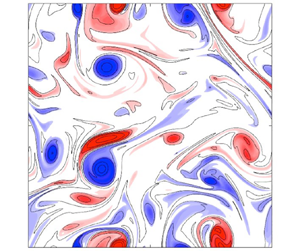Article contents
Selective energy and enstrophy modification of two-dimensional decaying turbulence
Published online by Cambridge University Press: 31 January 2023
Abstract

In two-dimensional decaying homogeneous isotropic turbulence, kinetic energy and enstrophy are respectively transferred to larger and smaller scales. In such spatiotemporally complex dynamics, it is challenging to identify the important flow structures that govern this behaviour. We propose and employ numerically two flow-modification strategies that leverage the inviscid global conservation of energy and enstrophy to design external forcing inputs that change these quantities selectively and simultaneously, and drive the system towards steady-state or other late-stage behaviour. One strategy employs only local flow field information, while the other is global. We observe various flow structures excited by these inputs and compare them with recent literature. Energy modification is characterized by the excitation of smaller wavenumber structures in the flow than enstrophy modification.
JFM classification
Information
- Type
- JFM Papers
- Information
- Copyright
- © The Author(s), 2023. Published by Cambridge University Press
References
REFERENCES
- 3
- Cited by


